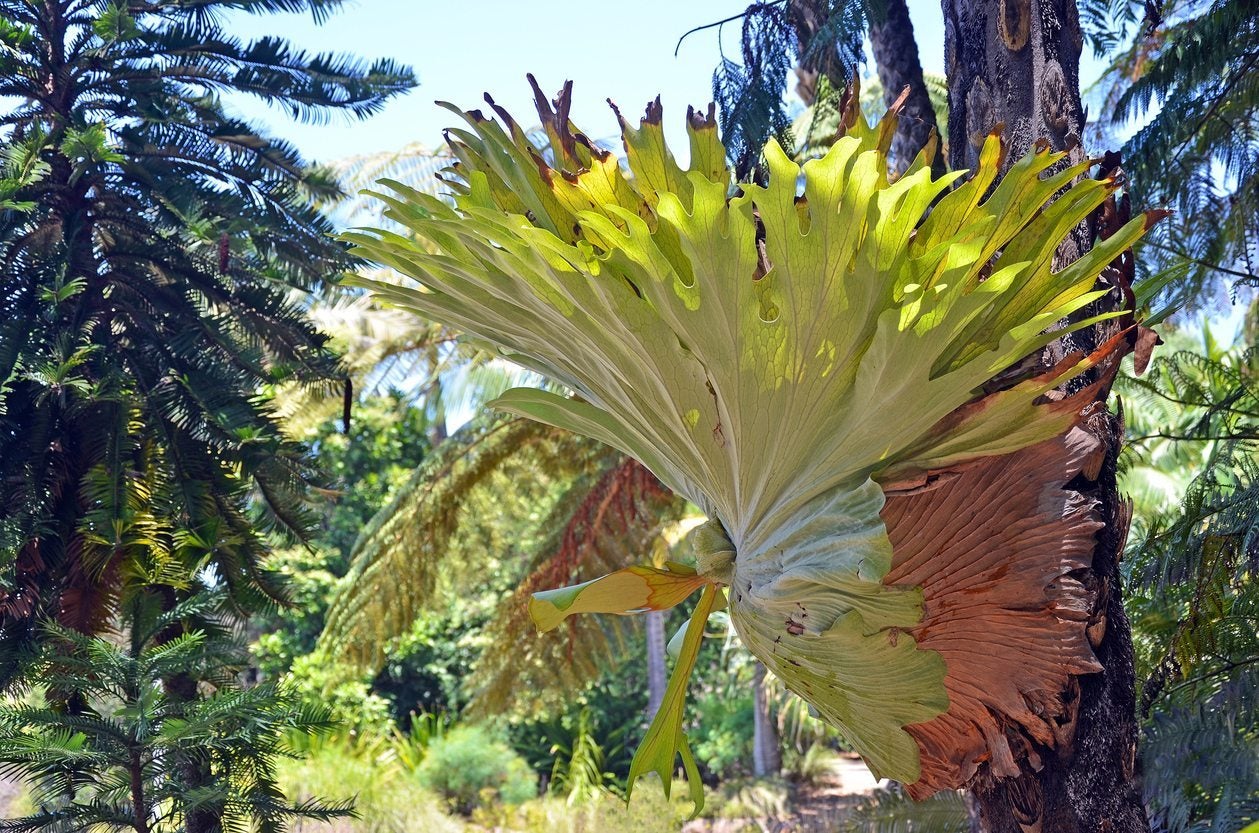Staghorn Fern Outdoor Care – Growing A Staghorn Fern In The Garden


At garden centers you may have seen staghorn fern plants mounted on plaques, growing in wire baskets, or even planted in small pots. They are very unique, eye-catching plants and when you see one it’s easy to tell why they are called staghorn ferns. Those who have seen this dramatic plant often wonder, “Can you grow staghorn ferns outside?” Continue reading to learn about growing staghorn ferns outdoors.
Staghorn Fern Outdoor Care
The staghorn fern (Platycerium spp.) is native to tropical locations of South America, Africa, southeast Asia, and Australia. There are 18 species of staghorn ferns, also known as elkhorn ferns or moosehorn ferns, that grow as epiphytes in tropical regions all over the world. Some of these species have naturalized in Florida. Epiphytic plants grow on tree trunks, branches, and sometimes even rocks; many orchids are also epiphytes. Staghorn ferns get their moisture and nutrients from the air because their roots do not grow in soil like other plants. Instead, staghorn ferns have small root structures which are shielded by specialized fronds, called basal or shield fronds. These basal fronds look like flat leaves and cover the root ball. Their main function is to protect the roots and collect water and nutrients. When a staghorn fern plant is young, the basal fronds may be green. As the plant ages though, the basal fronds will turn brown, shriveled, and may look dead. These are not dead, and it is important to never remove these basal fronds. A staghorn fern’s foliar fronds grow up and out from the basal fronds. These fronds have the appearance of deer or elk horns, giving the plant its common name. These foliar fronds carry out the plant’s reproductive functions. Spores may appear on the foliar fronds and look like the fuzz on a buck’s antlers.
Growing a Staghorn Fern in the Garden
Staghorn ferns are hardy in zones 9 to 12. That being said, when growing staghorn ferns outdoors it is important to know that they may need to be protected if temperatures dip below 55 degrees F. (13 C.). This is why many people grow staghorn ferns in wire baskets or mounted on a piece of wood, so they can be taken indoors if it becomes too cold for them outdoors. The staghorn fern varieties Platycerium bifurcatum and Platycerium veitchi can reportedly handle temperatures as low as 30 degrees F. (-1 C.). Optimal staghorn fern outdoor conditions are a part shade to shady location with plenty of humidity and temperatures that stay between 60 and 80 degrees F. (16-27 C.). Although young staghorn ferns may be sold in pots with soil, they cannot survive very long like this, as their roots will quickly rot. Most often, staghorn ferns outdoors are grown in a hanging wire basket with sphagnum moss around the root ball. Staghorn ferns get most of the water they need from humidity in the air; however, in dry conditions it may be necessary to mist or water your staghorn fern if it looks like it is beginning to wilt. During summer months, you can fertilize staghorn fern in the garden once a month with a general purpose 10-10-10 fertilizer.
Sign up for the Gardening Know How newsletter today and receive a free copy of our e-book "How to Grow Delicious Tomatoes".

Darcy is a former contributor to Gardening Know How. She is a professional landscape designer and gardening writer with experience in plant sales. An avid gardener, Darcy has a passion for sharing practical tips to help others grow.